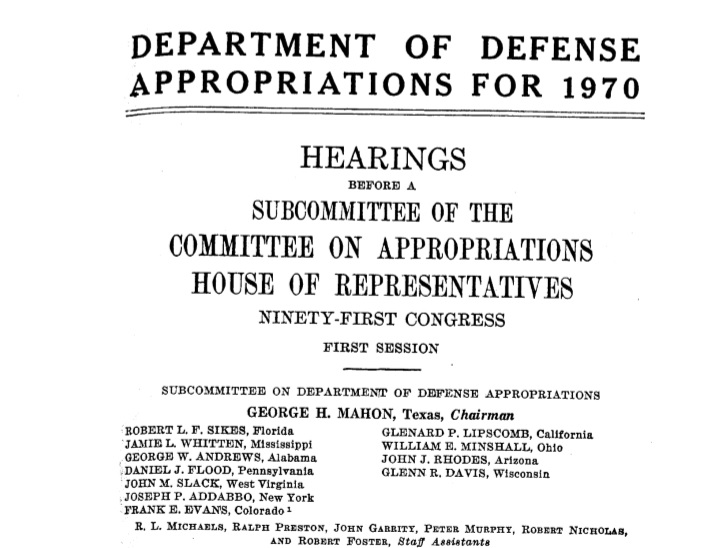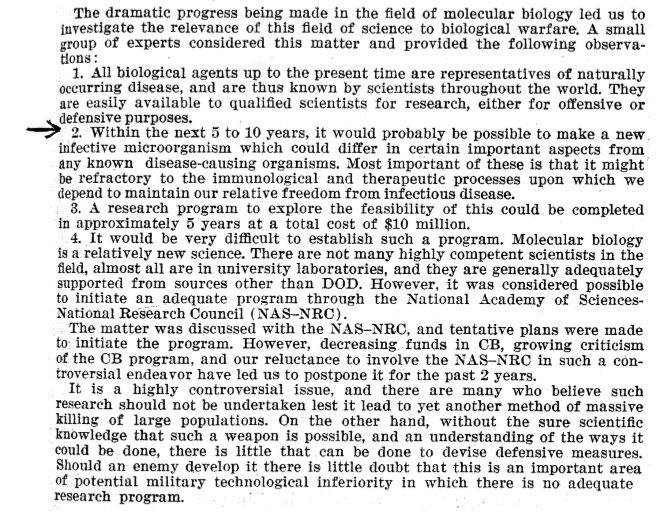U.S. contemplated viral weapons in 1969
At a hearing on June 9, 1969, the U.S. House of Representatives Subcommittee on Defense Appropriations heard testimony from Pentagon chemical and biological warfare officials calling for the inclusion of funds in the 1970 Defense Appropriations bill for the creation of "a new infective microorganism" that would be invulnerable to human immune systems. Dr. Donald M. MacArthur, the Deputy Director of the Department of Defense's Research and Engineering branch, testified that his efforts to create such a microorganism weapon that could defeat human immune defenses would cost $10 million over a five to ten year period. MacArthur was in charge of 76 Department of Defense laboratories at the time of his testimony.
Some ten years later, the world would be plagued by the Human Immondeficiency Virus (HIV)/Acquired Immune Deficiency Syndrome (AIDS), which plagued Africa, the gay community, heroin addicts, and hemophiliacs. More, recently, Ebola reached epidemic proportions in West Africa, with the virus being called "AIDS on steroids." The first case of Ebola was recorded in Zaire, now the Democratic Republic of Congo, in 1976.
MacArthur stated, on the record:
"Molecular biology is a field that is advancing very rapidly, and eminent biologists believe that within a period of 5 to 10 years it would be possible to produce a synthetic biological agent, an agent that does not naturally exist and for which no natural immunity could have been acquired."
The official also stated, "Within a period of 5 to 10 years it would probably be possible to make a new infective microorganism which could differ in certain important aspects from any known disease-causing organisms. Most important of these is that it might be refractory to the immunological and therapeutic processes upon which we depend to maintain our relative freedom from infectious disease…. A research program to explore the feasibility of this could be completed in approximately 5 years at a total cost of $10 million."
The program to jointly develop a synthetic microorganism weapon by the Department of Defense and the National Academy of Sciences/National Research Council (NAS/NRC)was postponed over the previous two years because of decreasing funding for the chemical and biological weapons program, "growing criticism" of the program, and a reluctance to involve the civilian NAS and NRC in the project.
MacArthur was joined in providing testimony to the subcommittee by Dr. B. Harris, Deputy Assistant Director for Chemical Technology within the Research and Engineering office; Dr. K. C. Emerson, Acting Deputy Assistant Secretary of the Army for Research and Engineering; Brig. Gen. W. S. Stone, Jr., Director of Materiel Requirement for the Army Materiel Command; and Col. J. J. Osick, Chief of the Systems and Requirements Divsion of the Directorate of Chemical, Biological, Radiological and Nuclear Operations of the office of the Army Assistant Chief of Staff for Force Development.
MacArthur's information was in answer to questions posed by Representative Robert Sikes (D-FL). Sikes represented the Florida panhandle where a number of military bases were located, including Pensacola Naval Air Station, Hurlburt Field, and Eglin Air Force Base. Sikes was known as a corrupt king of pork barrel projects and he was reprimanded in 1976 by the House for owning stock in defense companies that benefited from contracts he earmarked for his district.


Was the U.S. Army Medical Research Institute of Infectious Diseases (USAMRIID) at Fort Detrick ground zero for the viral weapons of HIV/AIDS, Ebola, and deadly E-Z measles vaccine?
In addition to HIV/AIDS first being detected in Cuban troops returning from Angola, where they were fighting against Central Intelligence Agency-supported guerrillas, and in Zaire and Sudan in 1976, the Edmonston-Zagreb (E-Z) vaccine for measles administered by the World Health Organization in the late 1980s and early 1990s to infants in Guinea, Guinea-Bissau, Senegal, Burkina Faso, Haiti, Vietnam, Mexico, Philippines, Egypt, and Argentina. Infant girls in Africa were given twice the dose as boys and, because their immune systems were suppressed from 6 months to years, many of the female infants died. At the same time, the Centers for Disease Control (CDC) and Kaiser Permanente administered the E-Z vaccine to largely African American and Latino infants in Los Angeles. The parents of the infants in Los Angeles were never told that the measles vaccine was experimental. Dr. David Satcher, the director of the CDC, said, "a mistake was made," adding, "it shocked me." The U.S. military's development of microorganism weapons in the 1970s may have behind Satcher's reaction of shock to such testing programs on unwary individuals in Los Angeles and in Third World countries around the world.
As WMR reported on October 22, a leaked December 15, 2009 cable from the U.S. embassy in Berlin to the U.S. State and Defense Departments revealed that German authorities hesitated to permit the transfer of hemorrhagic fever cultures from a German bio-research firm to the suspected biological warfare laboratory at the U.S. Army Medical Research Institute of Infectious Diseases (USAMRIID) in Fort Detrick, Maryland because the Germans feared the Army might "weaponize" the cultures. The German government specifically stated that the ability of Fort Detrick to "create replicating recombinant infectious species" of dangerous hemorrhagic viruses could violate international controls on the export of dangerous weapons of mass destruction that are enforced by the Australia Group of signatories to biological, chemical, and nuclear export treaties.
On October 16, the White House announced that it was cutting off funding to risky government experimentation that studied certain infectious agents by making them more dangerous.


The program to jointly develop a synthetic microorganism weapon by the Department of Defense and the National Academy of Sciences/National Research Council (NAS/NRC)was postponed over the previous two years because of decreasing funding for the chemical and biological weapons program, "growing criticism" of the program, and a reluctance to involve the civilian NAS and NRC in the project.
MacArthur was joined in providing testimony to the subcommittee by Dr. B. Harris, Deputy Assistant Director for Chemical Technology within the Research and Engineering office; Dr. K. C. Emerson, Acting Deputy Assistant Secretary of the Army for Research and Engineering; Brig. Gen. W. S. Stone, Jr., Director of Materiel Requirement for the Army Materiel Command; and Col. J. J. Osick, Chief of the Systems and Requirements Divsion of the Directorate of Chemical, Biological, Radiological and Nuclear Operations of the office of the Army Assistant Chief of Staff for Force Development.
MacArthur's information was in answer to questions posed by Representative Robert Sikes (D-FL). Sikes represented the Florida panhandle where a number of military bases were located, including Pensacola Naval Air Station, Hurlburt Field, and Eglin Air Force Base. Sikes was known as a corrupt king of pork barrel projects and he was reprimanded in 1976 by the House for owning stock in defense companies that benefited from contracts he earmarked for his district.


Was the U.S. Army Medical Research Institute of Infectious Diseases (USAMRIID) at Fort Detrick ground zero for the viral weapons of HIV/AIDS, Ebola, and deadly E-Z measles vaccine?
In addition to HIV/AIDS first being detected in Cuban troops returning from Angola, where they were fighting against Central Intelligence Agency-supported guerrillas, and in Zaire and Sudan in 1976, the Edmonston-Zagreb (E-Z) vaccine for measles administered by the World Health Organization in the late 1980s and early 1990s to infants in Guinea, Guinea-Bissau, Senegal, Burkina Faso, Haiti, Vietnam, Mexico, Philippines, Egypt, and Argentina. Infant girls in Africa were given twice the dose as boys and, because their immune systems were suppressed from 6 months to years, many of the female infants died. At the same time, the Centers for Disease Control (CDC) and Kaiser Permanente administered the E-Z vaccine to largely African American and Latino infants in Los Angeles. The parents of the infants in Los Angeles were never told that the measles vaccine was experimental. Dr. David Satcher, the director of the CDC, said, "a mistake was made," adding, "it shocked me." The U.S. military's development of microorganism weapons in the 1970s may have behind Satcher's reaction of shock to such testing programs on unwary individuals in Los Angeles and in Third World countries around the world.
As WMR reported on October 22, a leaked December 15, 2009 cable from the U.S. embassy in Berlin to the U.S. State and Defense Departments revealed that German authorities hesitated to permit the transfer of hemorrhagic fever cultures from a German bio-research firm to the suspected biological warfare laboratory at the U.S. Army Medical Research Institute of Infectious Diseases (USAMRIID) in Fort Detrick, Maryland because the Germans feared the Army might "weaponize" the cultures. The German government specifically stated that the ability of Fort Detrick to "create replicating recombinant infectious species" of dangerous hemorrhagic viruses could violate international controls on the export of dangerous weapons of mass destruction that are enforced by the Australia Group of signatories to biological, chemical, and nuclear export treaties.
On October 16, the White House announced that it was cutting off funding to risky government experimentation that studied certain infectious agents by making them more dangerous.


